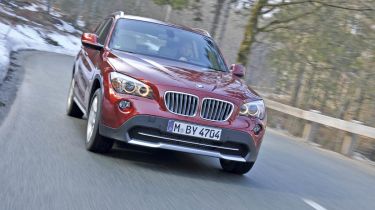BMW X1 xDrive28i
New petrol turbo debuts in baby crossover. Is it a wiser buy than the diesel?

Doubts still exist about the relevance of a big, powerful petrol baby SUV in this market, but even if the X1 28i has limited appeal, there is no questioning the potency or efficiency of the new BMW four-cylinder turbo petrol engine. Look out for it appearing in a wide range of the company’s models over the coming months and years.
Powerful six-cylinder engines look good in the showrooms, but that’s where they tend to stay... Although the extra price, weight and fuel consumption mean six-cylinders are great range-toppers, they’re often poor sellers.
BMW’s X1 crossover is a typical example. European buyers can specify a six-cylinder petrol engine, yet the maker’s UK arm doesn’t even bring this derivative to these shores, and offers only a range of diesels. That’s about to change with the introduction of the new 2.0-litre turbo in the model we drive here.
Video: watch CarBuyer's video review of the BMW X1
[[{"type":"media","view_mode":"content_narrow","fid":"68468","attributes":{"alt":"","class":"media-image"}}]]
It uses the same twin-scroll turbo technology as BMW’s 3.0-litre six-cylinder engine, so it spins quickly for rapid responses. As a result, the motor pulls hard from low revs and gives linear delivery. This unit replaces the straight-six offered in European X1s, and will be rolled out across BMW’s range over the next year. The 3.0-litre six-cylinder will remain for those who simply must have those extra pistons.
Used - available now
With variable timing, BMW’s Valvetronic control of the intake valves and intelligent use of the alternator, oil pump and water pump, the new engine delivers impressive economy in the X1. It returns 35.8mpg on the combined cycle, while 183g/km emissions mean £200-a-year road tax.
This efficiency doesn’t come at the expense of pace, though, as the car can sprint from 0-62mph in 6.1 seconds and go on to a top speed of 149mph. What’s more, given the engine’s huge flexibility, the six-speed manual box – or the eight-ratio auto in our model – are superfluous. The brakes and chassis can more than handle the engine’s power, too. Turn-in isn’t on par with a 1-Series, but it’s good for a small SUV.
The xDrive 4x4 system coped well with the ice and slush of the German roads we drove on; that’s about as much rugged ability as this tarmac-biased model is likely to need. Add into the mix a
comfortable ride, and the X1 will cover long distances with ease.
The rest of the package isn’t much different – which is good and bad news. There’s a roomy interior, with a smart, understated facia that will be familiar to BMW owners. There’s more load room than in a Nissan Qashqai, too.
But legroom in the back is tight for those over six foot tall. And we don’t like the way interior quality drops further back in the cabin. It starts out upmarket for the driver, yet gets a bit low rent by the time you reach the boot.










